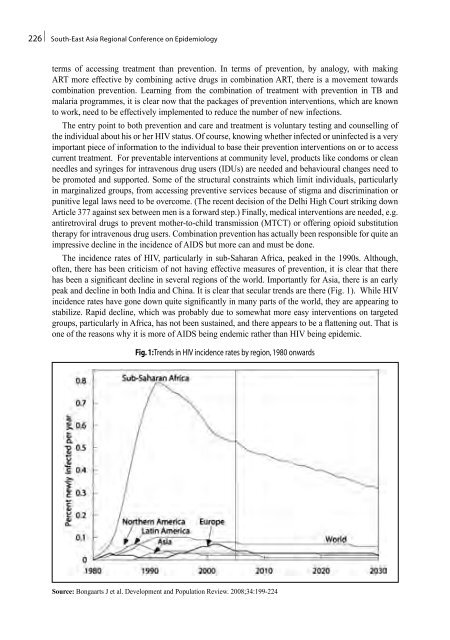South-East Asia Regional Conference on Epidemiology
South-East Asia Regional Conference on Epidemiology
South-East Asia Regional Conference on Epidemiology
Create successful ePaper yourself
Turn your PDF publications into a flip-book with our unique Google optimized e-Paper software.
226 | <str<strong>on</strong>g>South</str<strong>on</strong>g>-<str<strong>on</strong>g>East</str<strong>on</strong>g> <str<strong>on</strong>g>Asia</str<strong>on</strong>g> <str<strong>on</strong>g>Regi<strong>on</strong>al</str<strong>on</strong>g> <str<strong>on</strong>g>C<strong>on</strong>ference</str<strong>on</strong>g> <strong>on</strong> <strong>Epidemiology</strong><br />
terms of accessing treatment than preventi<strong>on</strong>. In terms of preventi<strong>on</strong>, by analogy, with making<br />
ART more effective by combining active drugs in combinati<strong>on</strong> ART, there is a movement towards<br />
combinati<strong>on</strong> preventi<strong>on</strong>. Learning from the combinati<strong>on</strong> of treatment with preventi<strong>on</strong> in TB and<br />
malaria programmes, it is clear now that the packages of preventi<strong>on</strong> interventi<strong>on</strong>s, which are known<br />
to work, need to be effectively implemented to reduce the number of new infecti<strong>on</strong>s.<br />
The entry point to both preventi<strong>on</strong> and care and treatment is voluntary testing and counselling of<br />
the individual about his or her HIV status. Of course, knowing whether infected or uninfected is a very<br />
important piece of informati<strong>on</strong> to the individual to base their preventi<strong>on</strong> interventi<strong>on</strong>s <strong>on</strong> or to access<br />
current treatment. For preventable interventi<strong>on</strong>s at community level, products like c<strong>on</strong>doms or clean<br />
needles and syringes for intravenous drug users (IDUs) are needed and behavioural changes need to<br />
be promoted and supported. Some of the structural c<strong>on</strong>straints which limit individuals, particularly<br />
in marginalized groups, from accessing preventive services because of stigma and discriminati<strong>on</strong> or<br />
punitive legal laws need to be overcome. (The recent decisi<strong>on</strong> of the Delhi High Court striking down<br />
Article 377 against sex between men is a forward step.) Finally, medical interventi<strong>on</strong>s are needed, e.g.<br />
antiretroviral drugs to prevent mother-to-child transmissi<strong>on</strong> (MTCT) or offering opioid substituti<strong>on</strong><br />
therapy for intravenous drug users. Combinati<strong>on</strong> preventi<strong>on</strong> has actually been resp<strong>on</strong>sible for quite an<br />
impressive decline in the incidence of AIDS but more can and must be d<strong>on</strong>e.<br />
The incidence rates of HIV, particularly in sub-Saharan Africa, peaked in the 1990s. Although,<br />
often, there has been criticism of not having effective measures of preventi<strong>on</strong>, it is clear that there<br />
has been a significant decline in several regi<strong>on</strong>s of the world. Importantly for <str<strong>on</strong>g>Asia</str<strong>on</strong>g>, there is an early<br />
peak and decline in both India and China. It is clear that secular trends are there (Fig. 1). While HIV<br />
incidence rates have g<strong>on</strong>e down quite significantly in many parts of the world, they are appearing to<br />
stabilize. Rapid decline, which was probably due to somewhat more easy interventi<strong>on</strong>s <strong>on</strong> targeted<br />
groups, particularly in Africa, has not been sustained, and there appears to be a flattening out. That is<br />
<strong>on</strong>e of the reas<strong>on</strong>s why it is more of AIDS being endemic rather than HIV being epidemic.<br />
Fig. 1:Trends in HIV incidence rates by regi<strong>on</strong>, 1980 <strong>on</strong>wards<br />
Source: B<strong>on</strong>gaarts J et al. Development and Populati<strong>on</strong> Review. 2008;34:199-224









